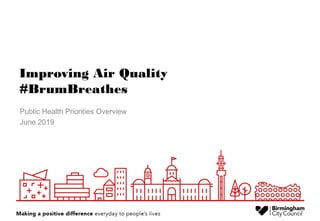Overview of Air Quality Approach in Birmingham
- 1. Improving Air Quality #BrumBreathes Public Health Priorities Overview June 2019
- 2. Birmingham Public Health Priorities The Public Health Priorities Green Paper set out some of the significant health issues affecting individuals, families and communities in Birmingham. This draws on analysis of the data and sets out some of the evidence based opportunities for action by individuals, organisations and strategic partnerships. This presentation is part of a suite of resources supporting the Green Paper, providing background information in each of the proposed priority areas. The Green Paper was consulted on in Spring 2019 and this consultation is informing the development of a new health inequalities framework for the city. PAGE 2
- 3. PAGE 3
- 4. PAGE 4
- 5. PAGE 5
- 6. WHAT IS AIR POLLUTION? Improving Air Quality
- 7. What pollutes the air in Birmingham Particulate matter (PM) is made of tiny particles in the air that can be breathed in. Smaller particles go through the lungs and into the blood stream. PAGE 7 ? There are several types of pollutant in the air. ? The two most important in terms of health impact are: ? Nitrogen Dioxide ? Fine particulate matter Nitrogen dioxide (NO2) is a gas that is created during combustion. In higher concentrations it can enflame the lungs.
- 8. How does pollution get into the air? PAGE 8 Percentages show relative contribution emitted nationally
- 9. PAGE 9
- 10. WHAT IS THE PICTURE IN BIRMINGHAM? Improving Air Quality
- 11. Air pollution in Birmingham ? Levels of particulate matter and Nitrogen Dioxide are highest around the city centre ? Some parts of Birmingham are in the most polluted 10% of areas in England ? On some roads in the city centre, levels of Nitrogen Dioxide are above the legal limit PAGE 11
- 12. Air pollution harms BirminghamˇŻs residents PAGE 12
- 13. Air pollution mapped PAGE 13
- 14. Transport is a major source of BirminghamˇŻs pollution PAGE 14
- 15. WHAT WILL MAKE IT BETTER? Improving Air Quality
- 16. The approach to changing the way we travel PAGE 16
- 17. PAGE 17
- 18. WHAT ARE WE DOING AT THE MOMENT? Improving Air Quality
- 19. PAGE 19
- 20. PAGE 20
- 21. Introducing a Clean Air Zone (CAZ) PAGE 21 ? The aim to is to reduce the levels of Nitrogen Dioxide in the city center ? To include all the roads within the Middleway Ring Road (A4540), but not the Middleway itself ? To be introduced in 2020
- 22. Other actions we are taking ? Work across local authority boundaries to address regional air pollution and cleaner ways to travel into Birmingham from outside the area. ? Working with partners to develop an integrated transport system, so that walking, cycling and public transport join up to make every day journeys easier through active travel. ? Integration of air pollution reduction into standard urban and transport planning and design practice across the city. ? Work with healthcare professionals to promote physical activity with patients for health benefit, and as part of this promote active travel options. ? Work with schools to encourage walking and cycling to and from schools for parents and children, alongside supporting bike-ability skills in schools. PAGE 22
- 23. How individuals can make a difference PAGE 23
- 24. PAGE 24
- 25. Tell Us What You Think ? This presentation is one of a group of slides that sets out the priorities for the publicˇŻs health in the city of Birmingham. ? The Public Health team are keen to hear what you think about the slides and whether they have helped understand the challenges facing the city. ? If you would like to give us feedback please email HealthyBrum@birmingham.gov.uk
Editor's Notes
- #8: Source: Defra Clean Air Strategy https://assets.publishing.service.gov.uk/government/uploads/system/uploads/attachment_data/file/770715/clean-air-strategy-2019.pdf
- #9: Source: Defra Clean Air Strategy https://assets.publishing.service.gov.uk/government/uploads/system/uploads/attachment_data/file/770715/clean-air-strategy-2019.pdf
- #10: Source: https://www.gov.uk/government/publications/health-matters-air-pollution/health-matters-air-pollution
- #13: Source: Birmingham Clean Air Strategy, consultation draft.
- #14: Taken from the Air Pollution maps in PHEˇŻs SHAPE tool: https://shapeatlas.net/
- #18: Source: https://www.gov.uk/government/publications/health-matters-air-pollution/health-matters-air-pollution


























